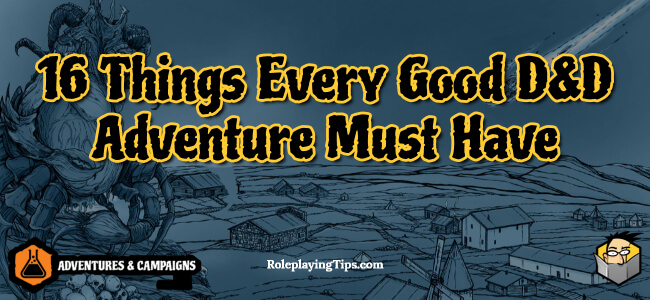SMOOSH JUICE
16 Things Every Good D&D Adventure Must Have – Roleplaying Tips

A Brief Word From Johnn
A quick note that Saturday is our monthly Q&A call on Zoom for Wizards of Adventure. Let me help you spruce up an encounter, tweak a plot, or solve a tricky campaign problem.
Also, if you cannot make the call, hit reply with your question(s). We’ll address them on the call and I’ll send you the recording.
I hope to see you there!
If you are not a Wizard of Adventure yet, get the details here. Join by Saturday morning to make the call.

Here’s a great list of essential adventure ingredients based on this video from Luke at The DM Lair on YouTube. Luke helped me out with a Kickstarter before — thanks Luke! — and I recommend his channel to D&D DMs.
16 Essential Adventure Ingredients
- Compelling Story
- Good Plot Hook
- Intriguing Villain
- Subservient Lieutenant
- Twist
- Enemies That Do More Than Just Attack
- Piece of Lore
- Balance Among the Three Pillars
- Interesting Encounters and Combats
- Variety of Encounter Difficulties
- Escalation and Rising Action
- Climax and Boss Fight
- Resolution
- Rewards
- Stakes for the World
- Stakes for the Characters
This is a strong list.
And if you don’t mind, I’d like to provide my take with d3 tips on each step. I won’t run this series 16 days in a row, but I’ll drop a few here and there over the next while until complete.
Let’s dig in!

#1 Make Stories More Compelling
1. Create a Character Connection
I’ve recently added “Connection” to my Encounter Stat Block. One option for that slot is tying a player character to the situation.
For example, in my Basilica campaign, the party finds a farmhouse recently burned out by Dogmen. If anyone sifts through the debris, they could find the land deed signed by the Baron himself — and it’s in the character’s family name.
With this connection, the entangled player is sure to take interest and investigate further.
2. Launch Them Out of a Cannon
Because we’re playing a game, our “stories” unfold as we play them. In a glorious, messy, unpredictable fashion.
We cannot control the PCs, but we can give them a strong push in the direction we want by shooting them out of a cannon (not canon — although both work here) aimed in that direction. I’ve not been used as ammunition in real life, but I imagine changing course mid-air is tough.
The first adventure, first encounter of that adventure, and first encounter each session are key GM moments where we tend to have more control.
The classic advice is to start with a Bang! Agreed. Start your campaign with a bang. Your adventures. And your sessions. Put the party on a trajectory towards your ideal grand finale or next milestone to ensure a compelling story develops through play.
The party can still deviate and become wandering monsters themselves, but they need to go against the cannon shot’s momentum during each of those key starting moments.
3. Add an Institution
More NPCs never hurts. 🙂 Connect adventure to setting via faction. This stirs the plot, adds layers to the onion, and gives you more mook and stage boss options.
For example, the PCs are hired to track down the killers of a farm family. Tracks indicate Dogmen.
Upon visiting the scene of the crime, a PC notices symbols blazoned into a couple of trees, fence posts, or buildings. These could be hobo code, and fresh marks could mean witnesses. The signs could be thieves’ cant advising already looted, a paladin’s oath of revenge on behalf of his order, or ranger’s warning to travellers.
Now the party not only has a lead, but they have something else to worry about.
Let’s say the farm encounter is from a published adventure you’re running. You can still add in the faction and fresh blazoned sign. If pursued, they could easily be left as dead end Red Herrings, with no witnesses or useful information, to facilitate faction insertion and not derail the adventure.
And now you can add the faction into gameplay wherever you like. You’ve forewarned the party. The faction could be appear as a second wave in a combat — whose side will they choose? The faction could be a clue provider if the party gets stuck. Or the faction could offer rivals and hooks as Back Pocket material if needed.

Ok, hopefully those d3 ways help make your stories deeper and more compelling. Which of these 3 techniques have you used lately? Got one I missed? Hit reply and let me know.
Cheers,
Johnn
roleplayingtips.com
https://discord.gg/6MxTRAqQ76
Have more fun at every game!
P.S. When you are ready, here are +4 vorpal ways I can help you with your campaign:
+1 Get My Campaign Logger App Free to Make Prep & GMing Easier
For GMs of any system looking to run deep, detailed, and immersive games, Campaign Logger lets you take session notes at the speed of thought in your unique GMing style while improving your preparation experience so you can focus on the parts of the game you enjoy the most.
Get your free Campaign Logger account here.
+2 Level-Up Your GMing With My Books
- Tiny Prep: Learn the perfect way to deliver epic sessions without the epic prep time.
- The Simple AI Guide to Adventure Building: Turn ChatGPT into your GM’s familiar, a smart assistant with an infinite well of ideas.
- NPC Mastery Bundle: A huge collection of tips, techniques, and aids that will inject life and detail into your NPCs
+3 Get the Demonplague (with 62 5-Star Ratings so far)
A complete level 1-20 campaign D&D 5E adventure path that offers intense roleplay, sandbox and hexcrawl play, cunning combats, and fiendish monsters.
Click here to see more details and to order.
+4 Get More GM Loot
Visit the Roleplaying Tips DriveThruRPG store, or browse books and courses to level up your GMing at the RoleplayingTips.com store.


